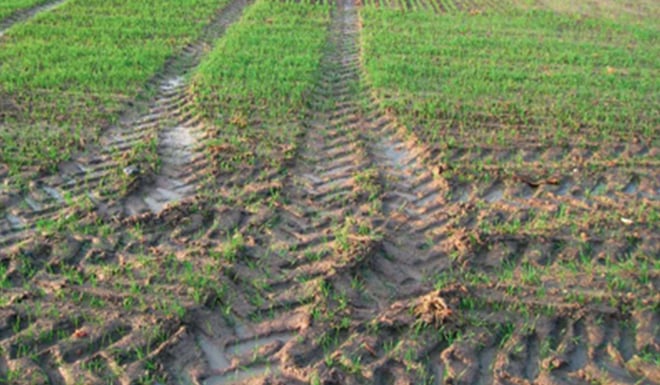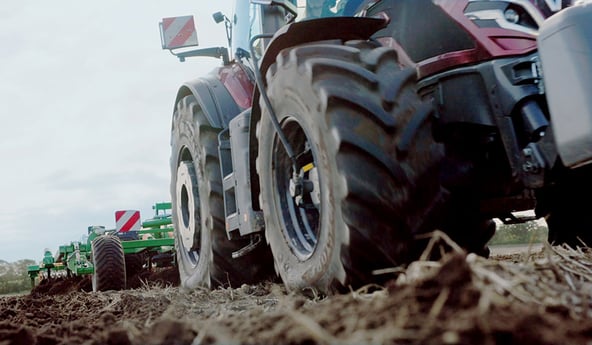The creation of ruts is a problem that frequently arises in orchards, vineyards and forest environments, where there are repetitive passages of farm machinery on the same spots during treatment and harvesting periods, sometimes in wet conditions.
Ruts can also occur in field crop contexts. Rut creation is often confused with soil compaction and while the two are related, they are usually not the same.
What is a rut?
A rut is a deformation of the soil surface in the shape of a narrow groove. It tends to hold water on the soil surface.
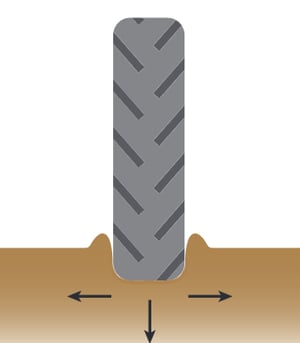
How are ruts formed?
Ruts occur when the pressure applied to the soil by the tractor or farm machinery is greater than the load bearing capacity. It happens when the wheels dig into the soil until the load bearing capacity and the pressure applied by the tyres even out (stable situation below).
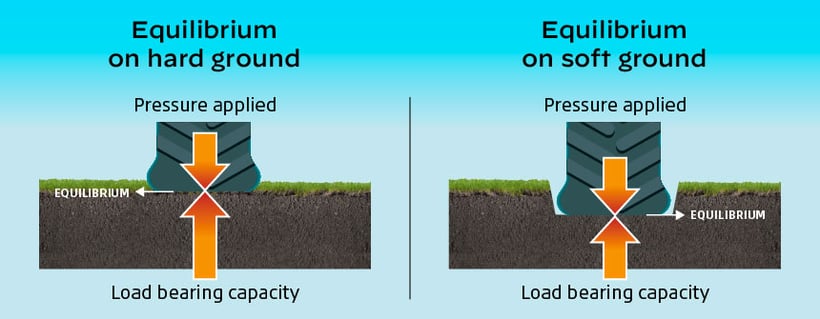
In dry conditions, ruts tend to be fairly small. However, repetitive and intensive passages of farming tyres or wet conditions can intensify them. The load bearing capacity depends mainly on the soil structure, its texture and humidity.
A wet soil, whatever it’s composed of, will be more liable to ruts as its load bearing capacity is lower. Clay soils are particularly sensitive as they have a lower load bearing capacity while sandy soils will have a higher load bearing capacity.
Are ruts a sign of soil compaction?
Ruts are not necessarily a sign of soil compaction (in this case, it may just be a ground movement) but there may also be compaction if the passage of the machinery has changed the soil structure. In this case, you may observe stagnated water at the bottom of the rut due to poor irrigation.
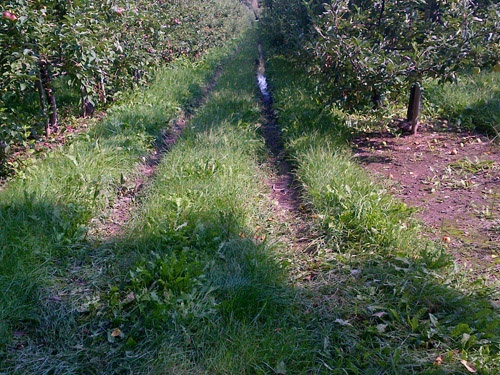 Photo of a rut with soil compaction in an orchard
Photo of a rut with soil compaction in an orchard
What problems do ruts cause?
Deep ruts will make it difficult to access your fields with farm machinery and increase fuel consumption.
Moreover, they also accelerate erosion by canalising the water that flows through the fields, deteriorating the quality of irrigation and limiting the storage of water deep down, while this water which should be stored can be vital during dry periods.
Ruts are also often a sign of poor quality or incompatible tyres, or of incorrect tyre pressure qwhich is often responsible for soil compaction.
It is important to limit the development of ruts deep down in the soil.
How to prevent rut formation?
To prevent the creation of ruts, take these three factors into account each time you work in the fields:
1. soil humidity,
2. tyre pressure,
3. the weight applied.
If your schedule permits, choose to work your fields in dry conditions.
If you really must work in wet conditions, choose low pressure tyres which distort well to spread the load (VF tyre, maxi-traction tyre…). Limiting the loads transported or using multiple axles (on trailers for example) can also be a solution. In extreme cases, you may choose to use caterpillar tracks.
How to get rid of ruts?
If you don’t do anything, it could take many years for a rut to disappear naturally. Levelling out the ruts will enable you to flatten the soil quickly.
Changing tyres is one solution against ruts, using wider, low pressure tyres (VF tyres) will allow you to better distribute the weight of the machinery and reduce the impact of repetitive passages on the soil structure.
You will need to make some changes if the use of suitable tyres is not enough. Tracks on which machinery is driven need to be covered with vegetation (grass for example), gravel or sand, to increase the load bearing capacity in areas of repetitive passages. Spreading out machine passages on the whole width available between crop rows will also reduce rut creation. You will need to compromise between the ground surface impacted and the reduction in damage achieved by spreading out the load.
Lastly, you need to consider the direction of the slope when determining your driving tracks in fields prone to erosion. If the driving lanes are parallel to the slope, the ruts formed will get deeper as water trickles down them. If they cannot be perpendicular to the slope, you may need to install a draining system from the top to limit the flow of rainwater in the field.
The bridgestone-agriculture.eu blog is written and administered by agricultural tyre experts who are available to provide you with the advice you need to maximise your productivity (How to ballast your tractor tyres – Technical data on farming tyres – Agricultural tyre performance – Pressure advice for agricultural tyres – Solutions for avoiding soil compaction – Sprayer tyre pressure - etc...)
To take it a step further and increase your farm’s profitability, the Experts du Pneu tractor blog has prepared a free, highly detailed eBook which explains the essential role of the farming tyre on your productivity.
Most people who read this article have also read some of the following articles:
- 9 major points on soil compaction linked to tractor tyres
- What you need to know about soil compaction caused by your tractor tyres
- Protect your soil during harvest for successful sowing in the future
- How to reduce soil compaction after harvesting?
- What are the consequences of the soil compaction caused by my tractor tyres?
- 3 soil conditions to understand to avoid compaction by your tractor tyres
This information is intended only to make you aware of the technical and functional aspects of agricultural tires and their use. It does not allow you to make a judgment or a definitive conclusion on a given problem. Only your agricultural tire expert is able to make a technical assessment and take a final decision, case by case.
Leave a
commentary
Your email address will not be published.
Required fields are indicated with *


